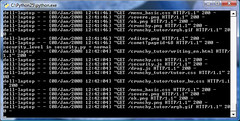Welcome to my Blog, maybe you’d like to add a link to your blog in the comments!
Steve Yegge on JavaScript, Rails on Rhino and other things
Back in June I blogged about Steve Yegge’s port of Ruby on Rails to Rhino (the JavaScript engine for the JVM) and his claim that JavaScript was the Next Big Language (NBL). In related news, Dion Almaer has just posted a new video interview (in the Google Code Blog series) of Steve Yegge himself talking about the Ruby on Rhino project, server-side and client side JavaScript. Its always nice to be able to put faces and voices to the names of people who have interesting ideas, and whose Blogs I am following. It’ll also be interesting to see what comes out of this project which Steve is pursuing at Google.
More Prevarication
While visiting InfoQ to read the article on Project Zero that prompted my last blog entry, I noticed that there was a video on Fortress (the new scientific programming language for the Java Virtual Machine that I first blogged about some time ago). In the video, recorded at the JAOO 2006 Conference, Guy Steele’s keynote The Soul of a New Programming Language gives a nice overview to the language and its philosophy. As a former MATLAB power user and ex-Fortran programmer, I find the Fortress language, particularly its use of mathematical notation, very intriguing and worthy of further investigation.
Why prevarication? Because I’m supposed to be marking exams!
Better Web Application Framework: Followup
While going through my feed-reader today, I came across another potential framework, which I can add to the list mentioned earlier. This is Project Zero, an incubator project being developed by IBM. It uses the Java platform and the scripting languages Groovy and/or PHP and seems to be directly targetted at RESTful services development but with support for traditional web applications, AJAX and mashups. I guess that I am going to have to I develop a data model and evaluate the choices that I have before I get even more confused!
Better Web Application Framework
Part of the requirements that I have been researching this last week have been concerned with the identification of a suitable web application framework for Python. I started out this week assuming that this would be [Django](http://www.djangoproject.com/) and even bought the [book](http://www.djangobook.com/)! However, because this is research, I have the luxury of time so I’ve done some additional research and decided that the alternative frameworks [TurboGears](http://turbogears.org/) and [Pylons](http://pylonshq.com/) were also worth a look. Searching Google for getting started screencasts and videos I discovered a [wonderful video](http://video.google.co.uk/videoplay?docid=6297126166376226181&q=turbogears&total=20&start=0&num=10&so=0&type=search&plindex=0) of a web application framework comparison presentation by Sean Kelly. In this presentation, Sean uses J2EE (Servlets and JSPs), Rails, DJango, TurboGears, Zope/Plone and even Enterprise Java Beans (JBoss) to develop a simple time-tracker application and reports his experiences. Rails, Django and TurboGears come out (roughly in that order), but the big surprise is that [Zope](http://www.zope.org/)/[Plone](http://plone.org/) comes out top! So, maybe I need to rethink!
I’ve embedded the video here as it’s not only a useful and timely comparison of web application frameworks, it’s also an example of just how useful and inspirational a simple presentation can be!
http://video.google.com/googleplayer.swf?docId=6297126166376226181&hl=en-GB
Powered by [ScribeFire](http://scribefire.com/).
New Blackboard Tools
Powered by [ScribeFire](http://scribefire.com/).
Winter Trees in Singleton Park
 Today my wife and I took a walk in Singleton Park and the botanical gardens and I snapped one or two interesting views with my new camera. I love the dramatic silhouettes that large deciduous trees make in the winter!
Today my wife and I took a walk in Singleton Park and the botanical gardens and I snapped one or two interesting views with my new camera. I love the dramatic silhouettes that large deciduous trees make in the winter!
This image has been converted to Black and White. There are more pictures on Flickr.
Jing Zing!
I am grateful to OUseful.info for the post that lead me to try out a new Screencasting tool from TechSmith called Jing. Made by the same company that makes SnagIt (an indispensable screen caspture tool) and Camtasia Studio (a screencasting tool that I covet but can’t afford), Jing is a “couldn’t be simpler” tool for making screencasts that you can share.
The results can be shared with others as videos via (charged for service) Screencast.com [see the headline link for an example], as individual images via flikr (see the image on this post), uploaded to a web site using FTP or saved to disk. It’s a great tool. This should be great for sharing video “how to’s” but as an academic who uses a PC in lectures, it seems possible that I could actually record a lecture with Jing and make it available as a video screencast within minutes of completing a lecture. This is an experiment I’m keen to try next term.
Warning for Vista users: Jing suffers from a problem that I’ve seen with a few apps since upgrading from XP to Vista. When Jing is installed, the user permissions are not set up properly and you have to manually take ownership of the installation folder in Program Files to get it and its shortcuts to show up! After that, it seems to work OK!
Crunchy Demos on ShowMeDo
André Roberge has created three screencasts on the use of Crunchy. Crunchy is an interactive Python interpretor that runs inside the Firefox browser and can be used to create interactive Python tutorials, library documentation, demos and tests. The principle is similar to “docucentric design” which was explored by one of my PhD students. The key benefit of the Crunchy approach is that documents are just web pages with embedded tasks. It is worth investigating whether Crunchy can be combined with a wiki to add some value to my current research project.
Happy New Year

It’s been a while since I blogged, but the reason is that I’ve been on holdiday with the in-laws in Regensburg (Bavaria: see picture) and am undergoing the always time consuming task of catching up with RSS feeds and email. Nearly three weeks worth this time!
I’ve spotted a few interesting things in the feeds that deserve further investigation and commentary, for now just check out the links that are tickling my fancy. These are taken straight from my Google readers starred items.
In the meantime, Happy New Year to (all) my reader(s).


